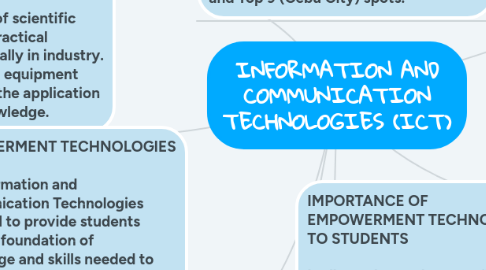
1. ICT IN PHILIPPINES Several International Companies dub the Philippines as the “ICT hub of Asian” There is huge growth ICT-related jobs around the country, one of which is the Call Center of BPO or Business Process Outsourcing Centers. In the 2013 edition of measuring the information society by the International Telecommunication Union. There are 106.8 cell phones per 100 Filipinos in the year 2012. In a data gathered by the animal society of Philippines Business and shares. NSO in 2010 the ICT industry shares 19.3% of the total employment population in the Philippines. Time Magazines “The Selfiest Cities in the World” of 2013 places 2 cities from the Philippines in the Top 1 (Makati) and Top 9 (Cebu City) spots.
2. EMPOWERMENT Authority or power to someone to do something. Based on the idea that giving students skills, resources, authority, opportunity, motivation, as well holding them responsible and accountable for outcomes of their actions will contribute to their competence and satisfaction.
3. TECHNOLOGY The application of scientific knowledge for practical purposes, especially in industry. A machinery and equipment developed from the application of scientific knowledge.
4. EMPOWERMENT TECHNOLOGIES Are information and Communication Technologies designed to provide students with the foundation of knowledge and skills needed to succeed in environments that require to use of computer and the internet.
5. IMPORTANCE OF EMPOWERMENT TECHNOLOGIES TO STUDENTS It allows the students to discover the world of ICT in general and also helps them improve their skills in various application. It allows the student to develop, promote and publish a campaign for social change using various free tools and services.
6. INTERNET Also known as the World Wide Web. Is a massive digital network that connects billions of electronic devices all over the planet. Has been a vital tool to our modern lives that is why it is also important to make the best of the internet.
6.1. 3 Generations of WEB Web 1.0 Web 2.0 Web 3.0
6.1.1. WEB 1.0 It is a term coined to differentiate the first stage of the World Wide Web (WWW) in comparison with the present stage of the internet technology. Web pages are static and were only read only web. Also known as flat or stationary page.
6.1.1.1. WEB 1.0 examples Web Directories- Yahoo, Altavista Web Catalogues- Amazon Business Directories- Alibaba, Yellow Pages Corporate Websites- Everyone got one Personal Pages- Everyone got one too.
6.1.2. WEB 2.0 Is a term coined by Darci Dinucci on January 1999 The term Web 2.0 was first used around 2004 Is the evolution of Web 1.0 by adding dynamic web pages Internet technology became more and more interactive. The users can now interact, contribute and create their own internet space and content.
6.1.2.1. WEB 2.0 examples Social networking sites Blogs Wikis Video sharing sites Hosted services Web applications Mash ups Folksonomies
6.1.2.1.1. Key Features of Web 2.0 User participation- other websites users can place content of their own by means of comments, reviews and evaluation. Some websites allow readers to comment on an article, participate in a poll or review a specific product. Mass participation- diverse information sharing through universal web access. Long tail- services that offered an demand rather than on a one time purchase. This synonymous to subscribing to a data plan that charges you for the amount of time spent in the internet or a data plan that charges you for the amount of land width you used. Folksonomy -allow users to categorize and classify/arrange information using freely chosen key words (e.g tagging). Popular social networking sites such as Twitter, Instagram, Facebook, etc. Use tags that start with the pound sign (#). This is also referred to as a hashtag.
6.1.3. Web 3.0 It is described by Tim Berners-Lee (father of www) as the read-write-executive web. It is referred to as the semantic web or data driven web content and response. The context of the search of the user is processed by a programming language to help the user by presenting options of that the person is interested in. It will not make web 2.0 obsolete.
6.1.3.1. Mobile Technologies This refers to the media devices such as mobile phones and PDAs which were the primary source of portable media from which we could obtain information and communicate with one another. More recently, the smartphone (which has combined many features of the cellphone with the PDA) has rendered the PDA next to obsolete. The growth of new mobile media as a true force in society was marked by smartphones sales outpacing personal computer sales in 2011.
6.1.3.1.1. Mobile Devices Operating System iOS Android Windows phone OS Blackberry OS Symbian Web OS Windows Mobile

